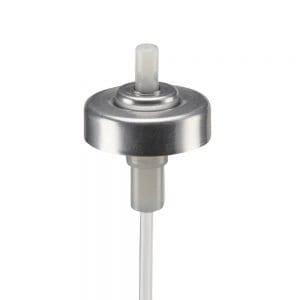Can Bluefirecans Valve Documentation Speed Product Approvals And Reduce Risk

A valve is a small component with big consequences for how a packaged spray behaves over time. When a brand chooses materials and assembly methods they are also choosing how long a product will remain safe, effective, and pleasant to use on the shelf. An Aerosol Can Valve that seals tightly, resists wear, and mates reliably with its actuator preserves formulation integrity and prevents losses from slow leaks. That foundational performance is why product teams, quality engineers, and procurement people treat valve selection as a shelf life decision as much as a mechanical one.
Leak control is the first and most obvious link to shelf life. If a valve allows even slow escape of propellant or formulation vapors the internal balance of pressure and solvent concentration shifts. That can change spray behavior, alter the ratio of propellant to active ingredient, and shorten useful life long before a consumer opens the package. Modern leak checks range from traditional immersion bubble tests to contactless tracer gas systems that detect minute losses without slowing the production line. Manufacturers rely on a mix of quick end of line screens and more sensitive lab checks on sampled lots so that leak risk is managed continuously rather than occasionally.
Dose consistency and spray character also determine how long a product is viable. Valves control the volume delivered per actuation and shape the plume geometry that deposits product where it is needed. If valve tolerances drift with age or under temperature swings the spray pattern and delivered dose can vary from one can to another. For measured dose products this variation undermines label claims and consumer expectations. That is why manufacturers include spray pattern and discharge rate tests in development and in production verification, so performance criteria remain tied to real use and shelf behaviour.
Mechanical life and material compatibility form the second axis of shelf life risk. Actuation cycling simulates repeated use and reveals wear on stems, seals, and gaskets that would otherwise appear only after months in market. Valves that show creeping torque, seal relaxation, or gasket shrinkage under cycling will often fail to deliver consistent doses late in life. Equally important is chemical compatibility: valves and their elastomers must tolerate the product formulation and any propellant without swelling or embrittlement. Design validation therefore blends life cycle actuation tests with material exposure trials so the chosen valve keeps sealing and actuating as intended.
Environmental resilience is a practical shelf life challenge. Storage and distribution expose cans to temperature swings, humidity, and vibration. Thermal cycling and humidity exposure can accelerate seal aging or change actuator behaviour. Vibration and mechanical shock during shipping stress crimps and caps. That is why stress simulations are part of qualification protocols and why decisions such as cap geometry and crimp specification are not cosmetic: they are chosen to protect the valve under foreseeable handling and transport regimes. Packaging instructions that ask for upright pallet orientation and cap protection are operational extensions of valve testing because they keep validated performance intact through distribution.
Production process controls and traceability close the loop between lab testing and shelf outcomes. A valve that passed prototype cycling still needs consistent assembly and crimping to perform the same way in every can. Batch level records, lot linked inspection logs and automated test data let manufacturers trace a performance incident back to a specific run and correct process drift quickly. That traceability speeds root cause work and limits the volume of product quarantined when an anomaly appears, which keeps supply flowing and prevents long, expensive recalls.
For buyers the practical implications are straightforward. Ask suppliers for documented evidence of leak screening, discharge and spray characterization, life cycle actuation logs, and environmental stress results that reflect your distribution reality. Also confirm compatibility trials with the actuators and closures you intend to use so that the valve that passed bench tests behaves the same in your filled can. Suppliers who publish valve notes and handling guidance make it easier to match expectations between product teams, procurement, and warehouse staff.
Safety and perception matter too. A valve that preserves formulation and prevents accidental discharge reduces incidents at retail and during transport, and it protects brand reputation. Consumers notice when spray patterns change or a product delivers less than expected; retailers notice when items return or claims rise. Choosing a valve with documented performance and pairing it with sensible packing practices keeps both safety and customer satisfaction on track.
In short, valve quality is a direct contributor to shelf life because it manages leaks, controls dose and spray, resists mechanical and chemical wear, and survives the distribution environment. When procurement teams treat valve selection as a technical, testable requirement rather than a cheap commodity they reduce aftermarket surprises and keep product experience consistent. If you want to read valve notes, view compatible actuators, and check packing guidance while specifying components, supplier product pages that gather test and handling details make approvals faster. Many vendors collect valve information and practical handling guidance on their technical portals such as the aerosol valve collection at https://www.bluefirecans.com/ which helps teams link valve choice to shelf life expectations.
- Art
- Causes
- Crafts
- Dance
- Drinks
- Film
- Fitness
- Food
- Jocuri
- Gardening
- Health
- Home
- Literature
- Music
- Networking
- Alte
- Party
- Religion
- Shopping
- Sports
- Theater
- Wellness
